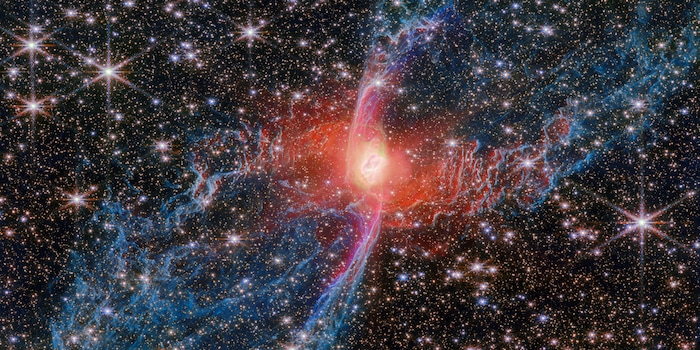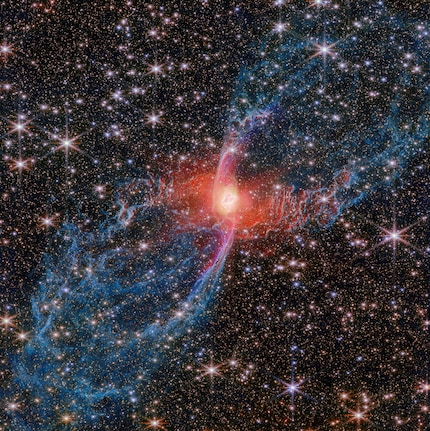
A red spider in the constellation Sagittarius
The James Webb telescope captured a colourful image of the planetary nebula NGC 6537 in the constellation Sagittarius, also known as the "Red Spider Nebula".
About 5000 light years away from us in the constellation of Sagittarius is the planetary nebula NGC 6537, which is nicknamed «Red Spider Nebula» due to its shape and colour. The image from the James Webb Telescope (JWST) was taken at different infrared wavelengths, so it does not reflect the visual view with the eye. From an astronomical point of view, planetary nebulae are short-lived structures that shine for a few tens of thousands of years before fading away.
Planetary nebulae form when a sun-like star runs out of fuel in its core. When such a star reaches the end of its existence on the main sequence of the Hertzsprung-Russell diagram, it first inflates into a red giant whose diameter exceeds that of our sun by a factor of 100. In the process, it ejects an extremely strong stellar wind that disperses a significant proportion of its total mass into the surrounding space, which accumulates around the dying star and forms an envelope.
If the energy-giving nuclear fusion reactions in the centre then cease, the core area contracts into a white dwarf, which is about the size of the Earth but can contain one and a half times the mass of the sun. The shrinkage causes the white dwarf to heat up considerably and emit a large proportion of its radiation in the high-energy ultraviolet range. The UV radiation then excites the surrounding masses of gas and dust, which the star has previously blown into space, to glow in the visual and infrared spectrum - a planetary nebula lights up.
In this image, the white dwarf is visible exactly in the centre of the picture, surrounded by a shell of dust, which appears reddish here. The central star also has a disc around it and could have a companion. Together with the disc, this could ensure that the planetary nebula has the shape of an hourglass, which is often observed. The JWST image also reveals for the first time the full extent of the gas bubbles ejected by the star, which glow bluish here.
Here is the image again in full format:

Spectrum of science
We are partners of Spektrum der Wissenschaft and want to make well-founded information more accessible to you. Follow Spektrum der Wissenschaft if you like the articles.
Original article on Spektrum.de
Experts from science and research report on the latest findings in their fields – competent, authentic and comprehensible.
From the latest iPhone to the return of 80s fashion. The editorial team will help you make sense of it all.
Show all